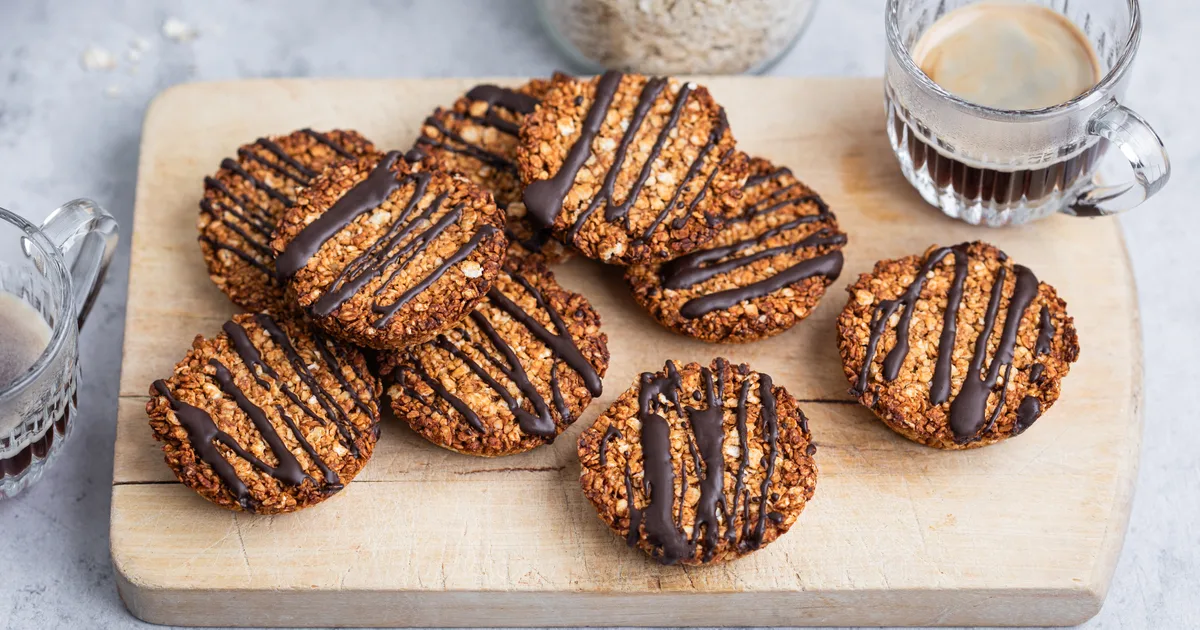
LOADINGERROR LOADING
When you’re comparing two snacks at the grocery store or gas station and want to pick the “healthier” one, you probably look for certain nutrients to be high (like protein) and others to be low (like calories, carbs, fat and sugar). Those are often the common characteristics we’re told are “healthy” and in the best interest of our bodies.
But what if that weren’t true — at least every time?
Personal trainer and TikTok creator Laura Ghiacy has an awesome series where she compares the nutritional facts of two similar foods, examining the “healthier” and “unhealthier” versions. For example, one video shows her comparing the nutrition facts of a Krispy Kreme pumpkin spice cake doughnut and a Lenny & Larry’s pumpkin spice protein cookie.
Advertisement
The numbers she shared are surprising.
The doughnut has 280 calories, 14 grams of fat, 2 grams of protein, 39 grams of carbs and 25 grams of sugar. The cookie has 440 calories, 15 grams of fat, 16 grams of protein, 58 grams of carbs and 27 grams of sugar. In short, the doughnut has fewer calories, fat grams, carbs and sugar (and it’s probably tastier).
It’s important to note that a food isn’t automatically “healthier” or “what your body needs” because it has fewer carbs, calories, fat or sugar. However, if you’re going to focus on that definition, like many people do, the snack you’re looking for may not be what you expected.
That festive example is far from the only one. Ahead, registered dietitians share more examples, plus the implications and their takeaways.
Advertisement
Grocery brand brownie bites vs. ProBar chocolate brownie
Grocery brand brownie bites
Calories: 130
Fat: 7g
Saturated fat: 1.5g
Sodium: 55mg
Carbohydrates: 15g
Fiber: Less than 1g
Added sugar: 9g
Protein: 1g
ProBar chocolate brownie
Calories: 270g
Fat: 5g
Saturated fat: 4g
Sodium: 370mg
Carbohydrates: 32g
Fiber: 2g
Added sugar: 13g
Protein: 20g
“Based on numbers alone, the only thing the ProBar wins on is protein, which would in fact make someone feel full longer, but otherwise it’s actually higher in sugar, carbs, saturated fat and excessively high in sodium,” said Megan Wroe, a registered dietitian and the wellness manager for Providence St. Jude Medical Center.
Bolthouse Farms protein plus coffee shake vs. Starbucks iced vanilla latte (grande)
Bolthouse Farms protein plus coffee shake
Calories: 400
Fat: 7g
Saturated fat: 3.5g
Sodium: 230mg
Carbohydrates: 55g
Fiber: 1g
Added sugar: 36g
Protein: 30g
Grande Starbucks iced vanilla latte
Calories: 190
Fat: 4g
Saturated fat: 2g
Sodium: 100mg
Carbohydrates: 30g
Fiber: 0g
Added sugar: 28g
Protein: 7g
“Starbucks wins in every category except protein, which is not really the point of a coffee drink anyway,” Wroe said.
Ken’s Steak House lite balsamic vinaigrette vs. Newman’s Own balsamic vinaigrette
Ken’s Steak House lite balsamic vinaigrette
Calories: 80
Fat: 7g
Saturated fat: 1g
Sodium: 360mg
Carbohydrates: 5g
Fiber: 0g
Added sugar: 4g
Protein: 0g
Newman’s Own balsamic vinaigrette
Calories: 90
Fat: 9g
Saturated fat: 1.5g
Sodium: 320mg
Carbohydrates: 4g
Fiber: 0g
Added sugar: 3g
Protein: 0g
“These two products are essentially the same,” Wroe said. “The differences of either are not significant enough to make any difference in a meal, and, notably, the ‘unhealthier’ standard vinaigrette is actually the one lower in carbs and sugar. Despite the marketing for the Lite version being healthier, the body would not notice any difference at all.”
Nature’s Own whole wheat bread vs. Kroger white bread
Nature’s Own whole wheat bread
Fiber: 2g
Vitamins and minerals: richer in calcium (50 mg versus 10 mg)
Texture and taste: dense, nutty
Kroger white bread
Fiber: 0g
Vitamins and minerals: richer in potassium (20mg versus 0g)
Texture and taste: soft, mild
“Whole bread may support digestive health due to fiber, but white bread can be easier to digest for some people, especially those with GI sensitivities,” said Jennifer Vittitow, a registered dietitian and the regional director of nutrition at Eating Recovery Center. “Both can be part of a balanced diet depending on individual needs.”
Advertisement
Whole milk vs. almond milk
Whole milk
Protein: ~8g per cup
Calcium: naturally occurring
Fat content: higher
Almond milk
Protein: ~1g per cup
Calcium: fortified or not present
Fat content: lower
“Whole milk offers protein and fat that can support satiety and nutrient absorption,” Vittitow said. “Almond milk may be preferred for those with a lactose intolerance or dairy allergy. … Neither is milk-superior, just different tools for different bodies.”
Breyer’s vanilla ice cream vs. Great Value plain nonfat Greek yogurt
Breyer’s vanilla ice cream
Sugar: 19g
Protein: 3g
Calcium: 120mg
Taste: sweet
Great Value plain nonfat Greek yogurt
Sugar: 7g
Protein: 17g
Calcium: 210mg
Taste: tart
Ice cream is a great option when you’re looking for a sweet treat; Greek yogurt is a great option when you’re looking for a protein-rich snack.
“Choosing one doesn’t cancel out the other,” Vittotow said. “They can coexist in a week of eating that honors both pleasure and nourishment.”
Advertisement
Kind dark chocolate nuts and sea salt bar vs. a full-size Snickers candy bar
Kind Dark Chocolate Nuts and Sea Salt bar
Calories: 180
Fat: 15g
Carbohydrates: 16g
Fiber: 7g
Sugar: 5g
Protein: 6g
Full-size Snickers candy bar
Calories: 250
Fat: 12g
Carbohydrates: 32g
Fiber: 1g
Sugar: 28g
Protein: 4g
In this case, the Snickers bar is higher in calories, carbohydrates and sugar — but that can be a good thing.
“The Snickers bar is tastier and overall has more chocolate (what we all crave most for flavor!),” said Deidra Sisk, a dietitian and certified eating disorder specialist at Ruby Oak Nutrition in Raleigh, North Carolina. “Plus, the carbohydrates and sugar are what our brains need to fuel work or school. … Choose the candy bar!”
Advertisement
In fact, nutrition experts can easily list the pros of carbs and sugar, noting they can help you exercise, are your brain’s preferred energy source, can strengthen your performance in the gym, can be digested quickly and support hydration.
What Does This All Mean?
Perhaps most, these examples highlight the power of (and inaccuracies that come with) marketing and diet culture. We’re told that the “lite” or “protein” option is always the “best” one, and that’s simply not the case.
“It’s so important for consumers to learn to be smart shoppers and know what is important to them on a label, rather than just reading the front of the package, which is what I call the product’s ‘billboard,’” Wroe said. “Reading labels empowers the consumer to make a choice based on what is right for their body’s needs and for the situation they are in.”
Advertisement
For example, if you’re looking for protein because you want to build muscle or feel full before a long day of work, you might opt for a protein cookie. If you want a cheap, sweet treat or some quick energy, you may grab the candy bar. When choosing a salad dressing, the “lite” option isn’t necessarily lighter, so opt for the one that tastes better.
Further, doctors say that many of us need to “cool it” with our protein obsession and focus on other nutrients.
When it comes to “healthy” vs. “unhealthy,” comparisons like these flip the script. “It shows that foods often labeled as ‘better’ aren’t automatically more nourishing or useful in every situation,” Sisk said. “Having the actual numbers and context gives people more freedom to choose what they enjoy, what feels satisfying or what fits their budget without guilt.”
Advertisement
Vittotow pointed out how this type of thinking can also help you make informed decisions without “food shame.”
“You gain clarity on what different foods offer — like fiber, protein or vitamins — without labeling them as ‘good’ or ‘bad,’” she said. “This helps you choose foods based on what your body needs in the moment: energy, comfort, satisfaction or nourishment.”
That can lead to an improved relationship with food, she continued, which can “reduce the emotional charge around eating” and help you “learn to trust your body’s signals and honor cravings.” In turn, you may find yourself bingeing less, restricting less, feeling more at peace, and having increased flexibility with food.
Advertisement
With that said, if you find that looking at food labels is more triggering than helpful, keeping this marketing concept in mind may be all you need. You may also benefit from seeing an anti-diet dietitian or certified intuitive eating counselor who can serve as a guide and supporter.
Remember: The ‘Healthy’ Option Is Different For Everyone
The takeaway here is that what your body needs may be different from what food marketing suggests, what that influencer is eating or what you ate yesterday. Our bodies need a variety of nutrients — and yes, that includes carbs, sugars and fats, not solely protein and fiber.
“For example, if someone needs a quick burst of energy before class, a candy bar might actually be the healthiest choice for them in that moment,” Sisk said. “Nothing is inherently wrong or unhealthy about the choice.”
Advertisement
She encouraged people to try to listen to their intuition and not overthink it.
Vittotow agreed. “Nutritional needs vary by person, day and context,” she said. “Comparing foods helps you understand options to pick from versus being dominated by diet culture rules. You stop chasing a one-size-fits-all ‘perfect diet’ (because in reality, there isn’t one) and start tuning into your own body’s wisdom.”
20 Years OfFreeJournalism
Your SupportFuelsOur Mission
Your SupportFuelsOur Mission
For two decades, HuffPost has been fearless, unflinching, and relentless in pursuit of the truth. Support our mission to keep us around for the next 20 — we can’t do this without you.
We remain committed to providing you with the unflinching, fact-based journalism everyone deserves.
Thank you again for your support along the way. We’re truly grateful for readers like you! Your initial support helped get us here and bolstered our newsroom, which kept us strong during uncertain times. Now as we continue, we need your help more than ever. We hope you will join us once again.
We remain committed to providing you with the unflinching, fact-based journalism everyone deserves.
Thank you again for your support along the way. We’re truly grateful for readers like you! Your initial support helped get us here and bolstered our newsroom, which kept us strong during uncertain times. Now as we continue, we need your help more than ever. We hope you will join us once again.
Support HuffPost
Already contributed? Log in to hide these messages.



